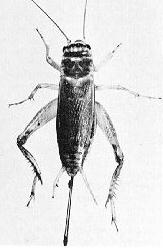 Managing Crickets - June 28, 2006 Jeff Schalau, County Director, Associate Agent, Agriculture & Natural Resources Arizona Cooperative Extension, Yavapai County Crickets belong to the insect order Orthoptera which also includes grasshoppers and katydids. While crickets may be considered nuisance insects because of their "chirping," none of them bite or carries diseases. However, they can cause damage to garden flowers, vegetable crops, clothing, fabric, carpeting, and furs. They are not difficult to control, but may be difficult to diagnose because they are most active at night. The chirping sounds for which they are famous are made by the adult males rubbing their wings together to attract females. Adult female crickets have long, sword-like ovipositors at the tip of their abdomens for laying eggs in the soil. Two species are commonly associated as household and pests in Arizona. These are Indian house crickets (Gryllodes supplicans) and field crickets (Acheta sp.). Indian house crickets are light yellowish brown or tan in color with darker bands and spots, about ¾ inch long when mature and are the most common and troublesome crickets. Indian house crickets were first observed in Tucson, Arizona in 1963. By the late 1970’s, they became common in many parts of the state and was the most common household pest recorded by household exterminators. Indian house crickets often gather around foundations and doors outside and readily come inside through cracks or openings. They are the only type of cricket that may live and produce young indoors. They typically hide during the day and come out at night to feed on crumbs, pet food, and plant debris. When there are extremely high numbers of Indian house crickets they may feed on fabrics and drywall. Outdoors, they may damage young garden plants and annual flowers. Field crickets are larger than Indian house crickets (slightly more than 1 inch when mature) and usually dark brown to shiny black in color. Field crickets prefer to live and breed outdoors where they feed on several kinds of plants, but may also enter houses and buildings. They do not produce young indoors. Field crickets are known to chew on and damage woolens, cottons, silks, synthetic fabrics, furs and carpeting. Clothes with perspiration stains or food spills are particularly attractive. Outdoors, they may damage young garden plants and annual flowers. The song of the field cricket is temperature dependent. The tone and tempo drop with a drop in temperature. Count the chirps in 13 seconds, add 40, and you will have the approximate temperature in degrees Fahrenheit. Use Integrated Pest Management (IPM) strategies to address cricket problems. There is no single, perfect solution for the control of crickets. Often some combination of the following cultural strategies control crickets in the home. Caulk and weather-strip all openings, cracks, gaps, and holes in foundation, siding, windows, doors, screens, and other possible entry points. Remove vegetation and debris that could serve as a hiding place or breeding site near the house. Keep all doors closed at night. Make sure all doors (including screen and garage doors) are tight-fitting. Keep lights off at night as much as possible or use bug bulbs, which don't attract insects. Put pet food away and keep kitchen clean. Check potted plants for crickets. Direct control (killing by hand) can be effective if not always easy. First you need to be able see and access the cricket, and then you use a fly swatter, vacuum cleaner, or shoe to kill it. Diatomaceous earth is also considered a mechanical control method. Place it between walls and other places where crickets hide during the day as well as to areas through which crickets walk. This abrasive, fine, white powder is actually tiny sharp fossil shells that will gradually wear through the cricket's outer shell, causing it to dehydrate and die. Wear a dust mask during application to prevent inhaling which could lead to respiratory problems. Natural enemies can also be effective. Many cats prey on crickets and keep indoor populations down. Keep cricket numbers down outdoors by encouraging natural enemies like lizards, garter snakes, birds, and non-venomous spiders. Cricket baits are particularly effective when applied indoors. Other over-the-counter insecticides should be used as a last resort. Some of these can also be used indoors if the label specifically allows. They should only be applied in cracks and crevices where crickets are suspected to be hiding. Spraying the air or applying insecticides to large, exposed surfaces is undesirable and mostly ineffective against crickets. Always follow label directions explicitly when using insecticides. The University of Arizona Cooperative Extension has publications and information on gardening and pest control. If you have other gardening questions, call the Master Gardener line in the Cottonwood office at 646-9113 ext. 14. Find past Backyard Gardener columns or submit column ideas at the Backyard Gardener web site: http://cals.arizona.edu/yavapai/anr/hort/byg/. |